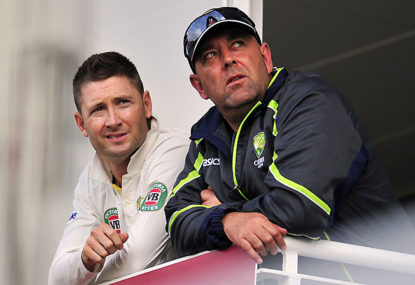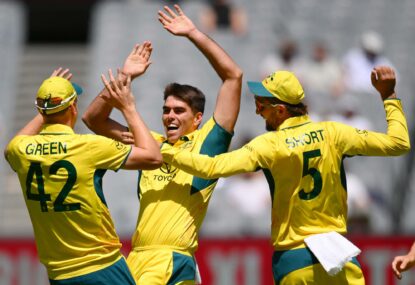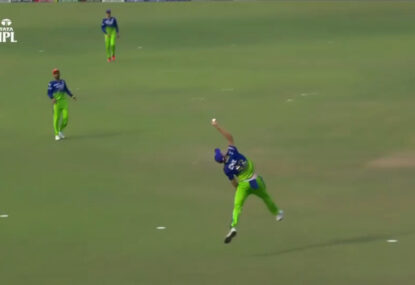It is often said that being Australian Test cricket captain is the second most important position anyone can hold, after the prime minister. Some might even argue that being Test cricket captain is more important.
In my time at least, it has in some instances been a poisoned chalice. Even those who have given outstanding service, firstly as player then as captain, have sometimes come to an inglorious exit.
When I first became aware of Test cricket in late 1967, Bobby Simpson was the Australian captain. After leading the team to two easy wins against India, Simpson announced he would not be touring England as a cricketer.
He had been offered something like fives times his cricket salary (or some similar ridiculous amount) to report on the tour as a journalist. The ACB promptly sacked him from the third Test team.
However, following a public backlash, he was recalled for the fourth Test, which at the time was assumed to be his last.
10 years later in 1977/78, Simpson answered an SOS call to captain a young, inexperienced team, again against India. This was following the defection of 20-odd leading players to WSC.
Simpson had a triumphant return, leading the Aussies to a 3-2 series win in an entertaining summer, and personally scoring two centuries.
However, things quickly turned sour in the Caribbean when both the Aussies and Simpson struggled against the Windies, firstly with their WSC stars in the first two Tests, then without.
When Simpson sought a guarantee to lead Australia for the entire 1978/79 season against England and was denied, he promptly retired a second time.
Simpson’s 1967/68 replacement was his long-time opening partner Bill Lawry, who brought a dourness to the position that was at odds with his personal good humour and gregariousness.
Lawry never felt comfortable in the position and was unceremoniously dumped from the final Test of the 1970/71 Ashes series, without even the courtesy of being advised beforehand. Don Bradman was chairman of selectors.
Ian Chappell became the new captain, and often told his teammates and friends, “those bastards (the selectors) won’t get me like they did Bill (Lawry)”. He was true to his word, retiring after defending the Ashes in England in 1975.
Almost everyone felt he had retired too soon. During Chappelli’s tenure, he took Australia to the top of the totem pole, the best team in the world.
Chappelli’s replacement was his younger brother Greg, who had a dream start, scoring twin centuries on his captaincy debut against the Windies in 1975/76.
Initially, the transfer of captaincy worked seamlessly, but cracks soon appeared in the 1976/77 summer, when whispers of WSC began to do the rounds. Greg Chappell was the default position Aussie skipper from 1975/76 right through to 1982/83.
However, due to World Series Cricket and his own unavailability on occasions, two other players assumed the captaincy during this period.
When Simpson failed to get a guarantee in late 1978 to continue as captain, the ACB plumped for the inexperienced Graeme Yallop. Although Yallop would successfully lead Victoria to back to back Sheffield Shield wins in 1978/79 and 1979/80, he was cruelly exposed at Test level.
During the summer he struggled to keep Australia’s new pace express Rodney Hogg under control. Late in the season, Hogg threatened to knock Yallop’s head off in a fiery exchange.
After six Ashes Tests, Australia played two Tests against Pakistan, who included their WSC stars. When Yallop pulled out of the final Test with injury, it appears the selectors couldn’t hand the captaincy quickly enough to someone else.
That ‘someone else’ was Kim Hughes, a talented batsman but emotionally fraught. Hughes had a brief run as captain, before Greg Chappell returning from WSC, reassumed the leadership in 1979/80.
Chappell was beginning to suffer the effects of the enormous pressure that went with the position. Consequently, he pulled out of two tours, to England in 1981 and again to Pakistan in 1982.
Hughes willingly filled the breach on both occasions. Finally, Hughes assumed the position in his own right in 1983/84, but his tenure would be brief and dramatic.
Hughes ran smack bang into the West Indies at their absolute peak. Given a team of variable quality and experience following the retirement of the ‘holy trinity’ – Greg Chappell, Dennis Lillee and Rod Marsh – both Hughes and Australia were overwhelmed, firstly in the Caribbean and then back in Australia in 1984/85.
After the second Test in Brisbane, Hughes tearfully and dramatically resigned the captaincy. He lasted just two more Tests, scoring 0, 2, 0, 0. He was a broken man.
Interestingly, Hughes went a long way to redeeming himself when he led the rebel Australians to South Africa in 1985/86 and 1986/87. The players generally respected his leadership and he batted quite well.
By contrast, his vice-captain in 1985/86, Yallop, was stripped of the captaincy for the following summer when it became apparent he had lost interest in the tours and the respect of his team mates.
December 1984, enter Allan Border.
Australia’s debt to Border is incalculable. For a few years, he was the only player of stature and experience in the national team. If ever a man carried a team single-handedly, it was probably Border during the tumultuous 1984/85, 85/86 and 86/87 seasons.
By 1987/88, with a surprise World Cup victory behind them, Australia now had a core of talented, experienced and confident players to assist Border.
Yet, despite his great deeds as captain from 1984-94, when Border sought leave of absence from Pakistan in 1994, the selectors advised him they could not guarantee his future selection.
Deeply hurt and offended, Border basically told the selectors to get stuffed and promptly retired. Although tellingly, he continued to play Shield cricket successfully for several more seasons.
Mark Taylor was the new captain and he built on Border’s hard work, eventually leading Australia back to number one position in 1995, when Australia beat the Windies in the Caribbean.
Taylor was considered an incredibly astute tactician, but his soft underbelly was leading Australia to some defeats in a ‘dead rubber’ match after series victory had been obtained. Taylor’s grip on the leadership loosened when he endured a prolonged batting slump during 1996-97.
Sensing the shift in public sentiment, Taylor retired at the end of the 1998/99 season.
Steve Waugh had replaced Ian Healy as Tubby Taylor’s deputy, and now he had the top job. Waugh adopted the same pragmatic, hard-nosed approach to the captaincy that he applied to his batting.
Under his leadership, Australia entrenched their position as the best cricket nation on earth, in both the long form and short form.
It seems towards the end of Waugh’s reign, a new kind of public characteristic was apparent. The ‘short attention span’ of the modern human being was saying to Waugh, “Look, we’ve been following you as Test cricket captain for six years (1999-2004) but now we’re sick of you. We want to see Punter in charge”.
And so, despite his phenomenal success as captain, Waugh retired in 2004/05, handing over the reigns to Ricky Ponting. By now, the Australian team was so talented and successful, the proverbial drover’s dog could lead and they would still be winning in a canter.
For a long time, Punter could do no wrong, as Australia’s success continued unabated, with only a blimp here or there. One blimp (2005) was excusable, but not two (2009) or three (2010/11).
By now, fans were beginning to get sick of Ponting as they had got sick of Waugh. “Time for a change” was the clamour, “Give that young pup Michael Clarke a go”.
Initially, Clarke was seen as a breath of fresh air, but back to back double debacle series defeats against India and England in 2012-13 saw the worm turn slowly against Clarke. Now it seems, the public are tiring of Clarke as they tired of Ponting and Waugh before him.
However, Clarke faces other problems. Despite his imaginative on-field captaincy, questions regarding his man-management remain.
It is suggested personal enmity between Clarke and former players Simon Katich and Michael Hussey hastened the retirement of these tow very fine cricketers.
There are also suggestions that Clarke is at loggerheads with chairman of selectors Rod Marsh, while his relationship with coach Darren Lehmann runs hot and cold.
Next man up is Steve Smith, who has already enjoyed a brief and successful stint as skipper. However, Smith must feel some trepidation in accepting the most coveted position in Australian sport.
Being in the spotlight, everyone wants a piece of you. And as past experience shows, the public can tire of you very quickly, no matter what great deeds you performed in the past.





































































































